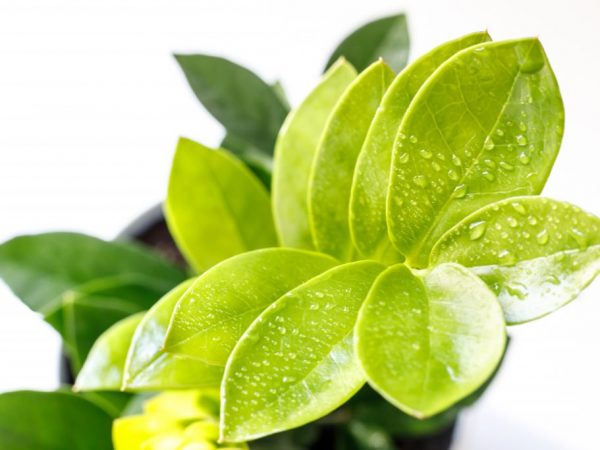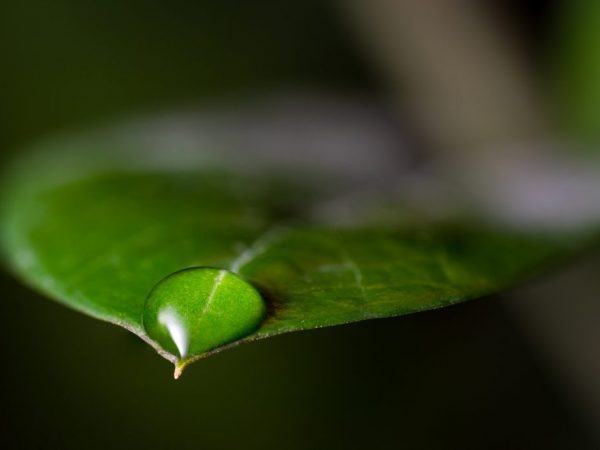Zamioculcas crying - the main reasons and rules for caring for a flower
Many inexperienced flower growers are worried about the moments when the zamiokulkas cries. And for good reason - it really can be a sign of a plant disease. How to be? First you need to determine for what reason drops appear on the green part. And how to care for this flower in general.

Zamiokulkas crying
Plant features
Zamioculcas belongs to the Aroid family, like Monstera, Philodendron and Calla. But if they need regular irrigation of the soil, then zamioculcas do not.
Under natural conditions, this plant chooses tropical regions of Africa. And there, as you know, the temperatures are never low, and the humidity level is constantly changing due to climatic instability and seasonal precipitation. In such areas, it is the succulent green leaves that help him survive.
At home, too, you should not water the soil in which the flower grows too often. Otherwise, its roots will rot, and over time they will lose all conductive properties. This will lead to the death of the culture.
main reason
There is no need to panic if drops appear on the tips of the leaves. In nature, this phenomenon is called guttation. It occurs when the soil is too saturated with water. It somehow gets inside, and if it accumulates, the plant removes it through the leaf tissue. In this he is helped by special glands - hydatodes.
What if the process takes place at home? Stop watering and only resume watering after a few weeks.
The regimen for zamioculcas during gutting is once every 10 days and every 20 (in winter).
But it is better to judge not by time, but by the state of the soil at a particular period. To test, take a pencil or wooden stick and submerge it in the ground for five minutes. If the part that was in the ground turns out to be slightly damp, repeat the watering early.
If you've taken a long break from watering, don't spare the water. It is poured so that liquid begins to drip from the hole at the bottom of the pot.
Effects
With excessive watering, the trunk and leaves of the plant begin to wither. Brown specks appear on the tips. This usually signals that the roots have been attacked by rot.
To save a tropical flower, remove it from the pot, cut off damaged roots and burn them with activated charcoal. It is necessary to dry the roots, and return the zamioculcas to an enriched soil with low humidity. It can only be watered after a couple of days.
If the leaves are covered with strange holes, this indicates that the plant is cramped in the container, and its root system is in a depressed state. Try to arrange a transplant and pick up a larger pot. Zamioculcas has powerful roots, so it is better to choose something from porcelain or ceramics.
Check the roots as you change the pot. Rotten ones are removed as quickly as possible.
If the leaves dry and curl for no apparent reason, you need to check the condition of the roots. This sometimes happens when the roots rot or become moldy. Try to treat them with foundation, change the soil and water the zamioculcas only occasionally.
But even these measures are unlikely to help: the plant can hardly restore the vegetative part if it is grown under artificial conditions.
Pests

A drop of water can indicate danger
Sometimes the reason for the appearance of water droplets on the zamiokulkas is not excessive watering, but a lesion with a scale insect, aphids or a spider mite. Additional symptoms include tiny brown plaques, as well as a change in the shape of the leaves.
Can a flower be saved? Yes, but you need to do it quickly. First, you should treat the affected areas with soapy water with a low concentration, it is especially important to rinse the tips and bases of the leaves. After that it is necessary to spray the aboveground part with insecticides. Among the time-tested remedies against pests are Actellik, Bankol and Aktara.
Diseases
Zamioculcas can also be affected by some diseases. In the conditions of Russia, powdery mildew and anthracnose are considered the most frequent.
Powdery mildew has this name because of the external similarity to dew: the plant is covered with small blobs with a bloom. It is treated with Skor, Topaz and the like.
Anthracnose is a fungal disease that manifests itself as dark green spots on foliage. It usually occurs when the flower lives in warm, high humidity conditions. For processing, copper sulfate or Bordeaux mixture is used.
There are also less obvious reasons for the appearance of droplets on the outside of the zamiokulkas leaf:
- The plant cannot live on the north window or exist without a personal lamp, because it needs a stable supply of light;
- Zamioculcas should have a large pot - its roots quickly fill the entire space;
- Collapsing stems need to be tied up; without support, they will provoke rotting;
- Avoid drafts and temperature extremes: This sensitive African flower does not survive below 19.

